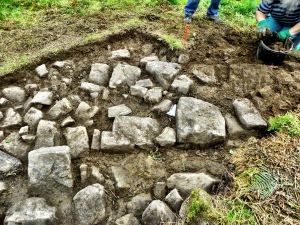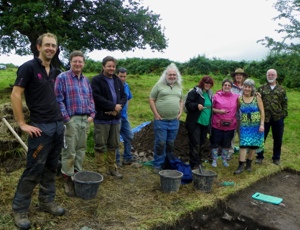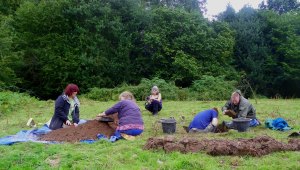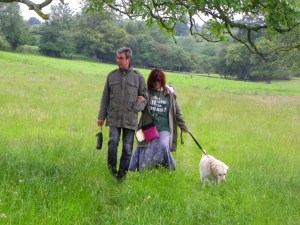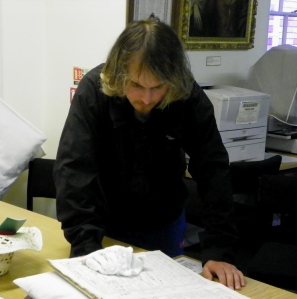A dozen people spent a large part of 18th October exploring how documentary evidence can help tell the story of the occupants of Studmarsh. We began in a café, ended in a pub, and spent a bit of time in the Record Office in between!
In many ways, historical research is like archaeology. We start by peeling off the upper layers, which seem to reveal nothing, but as we work away we begin to uncover evidence which may begin to fit together to tell a story that makes sense. The difference is that when doing historical research there are lots of different tools we have to use to get access to the buried evidence.
There are two periods of history in which we have a chance of finding specific information about Studmarsh:– just before the Reformation (the late middle ages to Tudor times), and the post-Reformation period, from about 1550 to 1750.
We began by looking at two poems by John Skelton, who lived through the transition between these two periods. Both were in English, and gave an idea of what life might have been like in late medieval Studmarsh. Mannerly Margery was wonderful when read by Jenny with her Irish accent! Eleanor Rumming was a bit harder to understand, but we still got a good idea of the power a woman could have in a small community if she brewed good ale, including plenty of detail of the household items people were willing to give her in exchange for a drink.
Tools
1.Names
Margery (or Margaret) and Eleanor were both very common names in medieval England. Name-choices can reveal a great deal about people and societies, and we noticed that, just like in our own time, children in the post-Reformation period were being given very different names from, say, their grandparents. Partly this would have been because of changes in beliefs (fewer saints’ names, more virtues like Patience), partly because of increased literacy (many biblical names appear just after the Reformation). We also talked about how names can help us to identify people in the past.
2. Wills
By late medieval times, more people were writing wills, and they become more common later. In the Hereford Record Office, wills are indexed in three ways, and we spent some time finding out how these work. We soon discovered that it is always important to write down the information you find as you go along.
The earliest ones (from 1400 to about 1540) are listed in a book called Faraday’s Probate Index. We looked at this, and found the index by surname at the back, the list by reference number near the front, and learnt what some of the abbreviations mean.
From 1540 to 1700, wills are in a hand-written index called Woodards, which is kept in two brown boxes, subdivided alphabetically by surname. Unlike Faraday, this does NOT cross-reference by surname variant, so for Biddle, for example, you also have to look under Beedle, Byddle and so on.
The most recent wills are indexed on films which are kept in blue boxes in the last of the wills film drawers. First you have to find the right time period. Then the film gives a photograph of a big ledger-type book, with lists of wills by surname. These are in initial letter order, but if a page was filled up, the person compiling the list would have to go on to the next empty page. So often you find that after three pages of ‘B’ surnames you go onto ‘C’ and ‘D’ before coming back to ‘B’. This may happen several times in one ledger. If the person you are looking for left a will, there will be an entry like: Biddle Richard 62. This means that in the next section of the film you will be looking for folio 62. We discover at this point that a folio has two sides, unlike our modern page numbers where each side has its own number! Folio 62 will have a short entry about Richard Biddle, including a date, his parish, key people named, and usually the total value of his wealth.
Once you have found an entry for a will which you think may be relevant, and have made a note of all the information included in the indices, you are ready to find it.
All the wills have been photographed so should be available to view on film reels. These are arranged in time order, and then in surname order, but neither system is exact, so it can take a long time to find one will. Once you have found it, the staff will help you to make a copy of it. Write its details on the back of every sheet.
These begin in Tudor times – some as early as 1539 and all parishes were supposed to have them by the 1580s. They are extremely valuable because everyone’s name should be in them at least twice – for their baptism and burial; everyone who married had a third entry, for that.
Registers are available on film in the Record Office, in alphabetical order by parish name.
Together wills and registers help us reconstruct how wide a person’s social network was, many details of their family life, times of disease, what personal possessions they had and so on.
Using these tools, we were able to ‘dig out’ several new pieces of information while we were at the Record Office.
One group got part way through looking for a will from the 1750s which may be relevant, and they plan to go back and finish finding it soon.
For Richard Biddle whose will we began with in the spring, we found his burial record which showed that he died in summer 1674. He was described as living on Bringsty [Common] and was buried in Bromyard; in his will he described himself as ‘of Linton’. We should be able to use this information to narrow down which house he lived in.
We found the will of William Colley of Norton, a contemporary of Richard Biddle, and now we must find out what it says.
We are still trying to discover if another William Colley, who held a lot of land in Whitbourne in 1577, is recorded in the parish registers. We also want to know if this is the same William Colley who lived at Studmarsh, or another person with the same name.
We did find the will of James Biddle, and now we need to find out what this says, too.
So, we are beginning to build up a more detailed picture, and fill in some gaps.
Now we can work out what the wills we have found so far mean, and see if they fit together. We are planning another day in November when we can get together again, and in the meantime we can have a go at looking at them in small groups. I’ll post them up on the Blog in a day or two.










